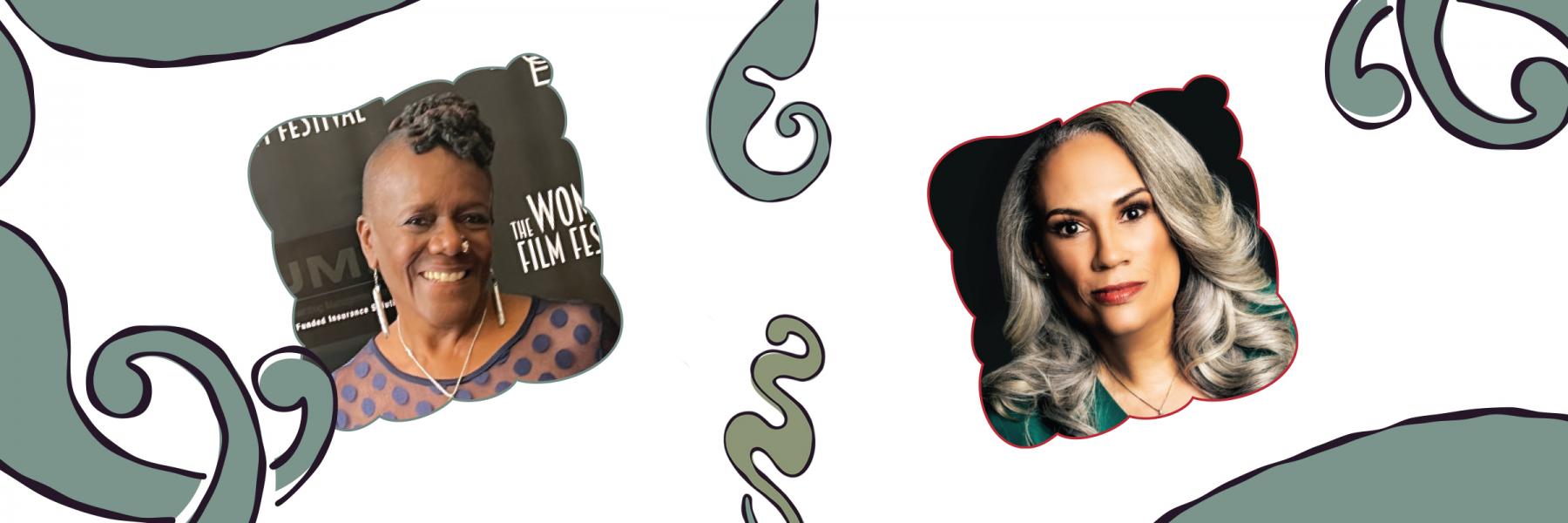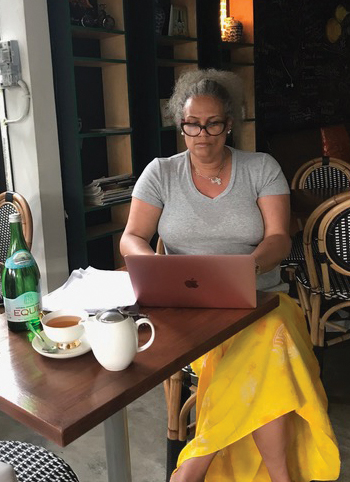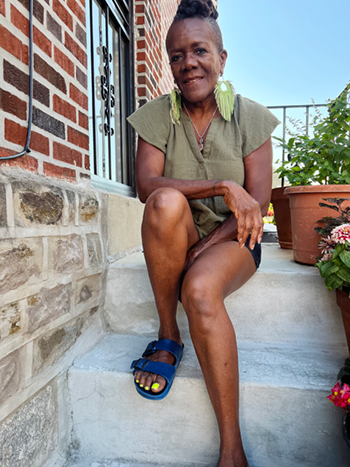A Conversation with Terri L. Wilder
Storytelling is part of many cultures around the world. It passes down the history of a people, educates and motivates them to make change. As a community, people living with HIV have used stories to speak truth to power, change policy, and document their lives as well as record the social movement they created. But is storytelling simply sharing information—orally, through the written word, or by filming history in real time? Or is it something deeper? I spoke with storytellers Asha Molok and Rae Lewis-Thornton about the “soul work” that one must engage in order to explore, unpack and process all of the necessary elements that are required to be a storyteller. They also discussed the legacy of this art in the Black community and why storytelling is in their DNA. Asha Molok is a retired Philadelphia school teacher and HIV advocate. She wrote and produced her first documentary, Fuel For The Fire: HIV Stigma in The Black Community, which has been selected to screen at several film festivals. Rae Lewis-Thornton is an Emmy Award-winning AIDS activist and renowned social justice advocate. She recently published her latest book, Unprotected: A Memoir.
Terri Wilder
You are Black women living with HIV and storytellers in a society that doesn’t value Black women. So, what has motivated you to not only tell your stories, but tell the story of others?
Asha Molok
I want to add one more thing: Ageism. Because I’m dealing with racism, sexism, ageism and I have HIV. I just feel like people living with HIV should tell their stories and always encourage people to write a book. We have the power to tell our story because we are living history right now. We should be able to control the narrative for when we’re not here. When this is over, what are they gonna say about us years from now? Well, you can control that by writing your story. I’m going to have my voice and I’m going to have my say.
Storytelling is an art. It’s an art that’s embedded in us. I wanted to find a way of doing a moving story. That’s what the documentary was about.
Rae Lewis-Thornton
I never wanted to tell this story. I actually kept it a secret for eight years. My first eight years I told five people that I was infected with HIV. And then when I transitioned to AIDS and death was facing me—back then the life expectancy for someone [diagnosed with AIDS] was 18 months—I began to really talk to God about my pain and my suffering, was there a point to all this? In the midst of transitioning to AIDS and dealing with a heavy pill load, someone asked me to speak at a high school. By the third workshop that day, young people were skipping class. The word had gotten out about ‘the woman with AIDS.’ And so everybody wanted to hear me. They had never really seen anybody with AIDS that wasn’t a White gay male. Because those were the television images. So it wasn’t that I wanted to do it, it was that God wanted me to do it. Six months later, [Essence magazine editor-in-chief] Susan Taylor met me, heard me speak for three minutes and then asked me to be on the cover of Essence, which changed the face for Black women with AIDS in America.
Black folks have been storytelling since forever. It was the only way we were able to communicate our pain, our suffering and our successes.
I wrote this memoir to tell this untold story of how violated and unprotected I was as a child, and how it shaped the trajectory of my life, because I believe that it’s a story that needs to be told. It’s one thing to talk about HIV, but it’s another thing to show how my life before HIV was shaped and led to HIV. I thought that it was time that we began to deal with the trauma. Thirty-eight percent of women infected with HIV are adult survivors of childhood sexual abuse. I believe that this is where I’m supposed to be in history. First it was with Essence and traveling the country, and now with my memoir, where I unpack issues that are not talked about—rape and violence in Black families.
TW Is storytelling part of a culture you grew up in?
AM I wrote two books. One was called Gaining Strength from Weakness: 101 Positive Thoughts for HIV Positive People; the second one was my memoir, The Underground Woman—From Prisoner to Freedom. Then I did the documentary. I actually took a community film class for emerging filmmakers. I had no experience when I took this class, I just knew that I had a story to tell. I wanted to find another medium to get that story out. My mother tells me that my father was a storyteller. They would go out somewhere, he would tell stories that would keep people captivated. People would just sit around and listen to these stories. My mother tells me, ‘you have the storyteller gene that you got from your father.’ I didn’t know that about him, but I know he used to talk to us a lot about different things. He would tell us about when he was in the war, when he was in France. He would tell us all these stories and we would listen, but I didn’t know that was storytelling at the time.
You have to unpack what happened to you, and kind of deconstruct it to create something whole and healthy.
RLT I grew up in a household where I was not nurtured, where I was unloved and the only dialogue that took place was a command, a demand, an admonishment. There were no conversations in my family, no encouragement growing up. I didn’t read my first book until I was 13. I talk about that in my memoir and about how trauma at a young age shrinks the brain and can cause learning disabilities. I really didn’t have anything except maybe the church. And the Bible and Bible stories. The Bible stories were a source of inspiration for storytelling; each story had so much power in and of itself that there were always lessons to learn. What I learned is that what comes from the heart (and not just from the heart) is all I have to give, and that has been my story. Zora Neale Hurston said, ‘If you are silent about your pain, they’ll kill you and say you enjoyed it.’
My first understanding of the plight of African Americans was through fiction books, like Black Boy and Native Son [by Richard Wright]. The stories of people’s pain came to life for me; I think it just became natural that I have never written a speech. I didn’t even write an outline for the book. I just told the story.
TW In storytelling it’s the opening—that first scene, that first quote, that first line—that draws the audience into the story. Asha, when I watched Fuel For the Fire, that opening scene is an arm, somebody’s pointing at the tattoo, and a person explains that the tattoo means, ‘that which doesn’t burn.’ Why did you open with that statement and that image?
AM Because that tattoo meant unburnable, that which cannot burn us up. They say that stigma fuels the fire of HIV. So, it’s like the people telling you their stories in a documentary; it’s not gonna let that burn them up. It’s not gonna let that harm them. I didn’t know I was going to open [the film] with that. I slept this documentary, I went to bed with it on my mind, I woke up with it on my mind. It was like, how am I going to transition from one part to the next? How am I going to open it up? When I was looking through all of the clips that I had, that was a scene from when we kept the camera rolling because my 17-year-old niece was my camera person. She had taken some film classes. She said you always let the camera keep rolling. So we just kept the camera rolling. We were breaking and clowning around. And so my niece said, ‘well, tell me about your tattoos.’ So [the woman] was explaining it, and when I looked at the clip, I was like, Oh, okay. I think I’m gonna start off with that, the unburnable. We are the unburnable.
TW It definitely grabs you. Rae, in your book right before the beginning, there is a quote from Dr. Nadine Burke Harris, ‘Unless you fix the trauma, the hole in the soul where the wound started, you’re working at the wrong thing.’ Why did you put that in the book’s opening?
RLT Because that is the thesis of the book. Growing up, I thought I was broken. I thought something was incredibly wrong with me. I would see myself going into situations but wouldn’t know how to stop myself. Sometimes it would be like an out of body experience. We spend a lot of time blaming people with HIV. We spend a lot of time blaming people who have addiction issues and we spend a lot of time asking the very question, what’s wrong with you? I asked it of myself. It’s really not about what’s wrong with you; it’s about what happened to you. And what happened to me was that I could see along the journey that I responded to an abnormal situation with an abnormal response, because that’s all I knew. We spend a lot of time trying to fix people, when the work is really soul work. You have to unpack what happened to you, and kind of deconstruct it to create something whole and healthy. The ACE [Adverse Childhood Experiences] study is one of the longest studies that has been done on the impact of childhood trauma to adult health outcomes. And it’s not just the typical stuff that we suspect, like drug addiction and incarceration, but it has to do with poor health outcomes like diabetes and heart disease. I think that we can actually reduce the cases of HIV if we begin to do the soul work.
We want to ‘Get to Zero with HIV,’ but giving people condoms and PrEP alone ain’t gonna solve the problem. Because the problem is what happened to them that shaped how they think. Young gay men, Black gay men being thrown away. Sex becomes love when that’s all you got. Until we begin to look at these issues in a holistic kind of way, we’re never going to get to zero. I was raped as a young girl, and I kept wanting to know why everybody wants to be fast with me and get me in trouble. That was my understanding of what was happening to me. Not that I was being raped, but that they were making me be fast. And so what became of my trajectory of life? Always in fight or flight, or freeze—never really having a chance to stop and say, ‘This is not me. What I’m doing right now is not who God created me to be.’ For me, that was the important piece of the book. It wasn’t that I was damaged; it wasn’t that I was broken. My abnormal response was to an abnormal situation, so it becomes your existence. Unless you begin working at the soul, all those superficial things don’t even matter. You can throw PrEP all day, you can tell me, ‘sex is a sin,’ you can shame me or try to get me to think differently—it’s gonna get lost because the trauma has been so powerful in the shaping of me that I don’t know anything else.
There were no conversations in my family, no encouragement growing up. I didn’t read my first book until I was 13.
AM I really understand what you’re saying. Because basically you’re talking about the root causes of HIV, and it’s like it’s all in our community. When you look at homelessness, at mental health, at domestic violence. You look at all of that, and those are the root causes. And until anything is done about that, nothing’s gonna happen.
RLT Right! And we’re homeless, we’re addicted, we are all those other things because something put us on that trajectory. And until we address the stuff that put us on this trajectory, we ain’t getting nowhere. And so, what I did in my book, I laid bare myself so that people can say, ‘Hey, you ain’t the only one. We all gotta do this soul work so that we can be who God created us to be.’ Because we’re more than HIV. We’re more than survivors of this and survivors of that.
TW I’d love to close by talking about what you think it is about storytelling that makes it such a powerful tool and so universally used in activism to make change.
RLT Black folks have been storytelling since forever. It was the only way we were able to communicate our pain, our suffering and our successes. We had to carry those stories down. I know that from the stories that I’ve read, it helps to situate me as a Black woman in America. It illuminates my understanding in a way. So, Black Boy or Native Son or Their Eyes Were Watching God [by Hurston], they hit the soul differently than The Mis-Education of the Negro [by Carter Godwin Woodson] or The Souls of Black Folk [by W.E.B Du Bois] kind of intellectual thinking. I believe that what comes from the heart touches the heart, and storytelling is the center of the heart. The center of the heart is the heartbeat, is where everything comes from.
AM Yes, and I agree with what you were saying about the storytelling like our ancestors, because back during slavery, they weren’t allowed to write. So they only had verbal storytelling, passing things down. When I think about my father, that’s what I think about; when I think about my grandfather, he would always tell a story, things that went on down south, and about my grandmother. Storytelling is an art. It’s an art that’s embedded in us. I wanted to find a way of doing a moving story. That’s what the documentary was about. I was saying that whatever your eyes see, it goes to your heart. I’m so glad for the audience that I had with the film festivals, because it’s an audience that probably would have never gotten some HIV information. When we would do talks with other filmmakers, I would say, ‘no, I don’t have any film experience. I just have a story in my heart that needs to come out.’ Maya Angelou said, “there’s no greater agony than bearing an untold story inside of you.” I was bearing a story in my heart, and it needed to come out.
When this is over, what are they gonna say about us years from now? Well, you can control that by writing your story.
RLT It needs to come out, exactly. Whether it’s the written word, or it’s a visual, the point is the same. We want somebody to say, damn, I get that. Because what comes from the heart touches the heart.
This conversation has been edited for clarity, length and flow.
Terri L. Wilder, MSW is a social worker, writer, and activist. She has worked in HIV since 1989 providing HIV social services, coordinating education for clients and medical providers and advocating for policy change. She has presented at local, national and international conferences on a variety of HIV topics. She served on the New York Governor’s Task Force to End AIDS (EtE), the New York Governor’s Hepatitis C Elimination Task Force and is currently a member of the New York State Department of Health AIDS Advisory Council EtE Subcommittee.




